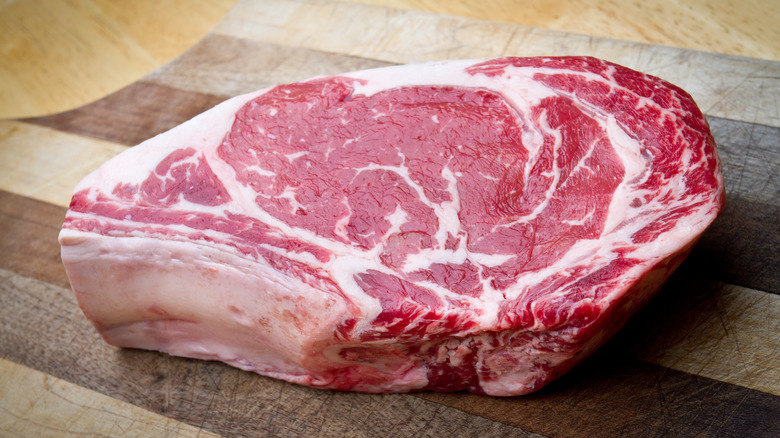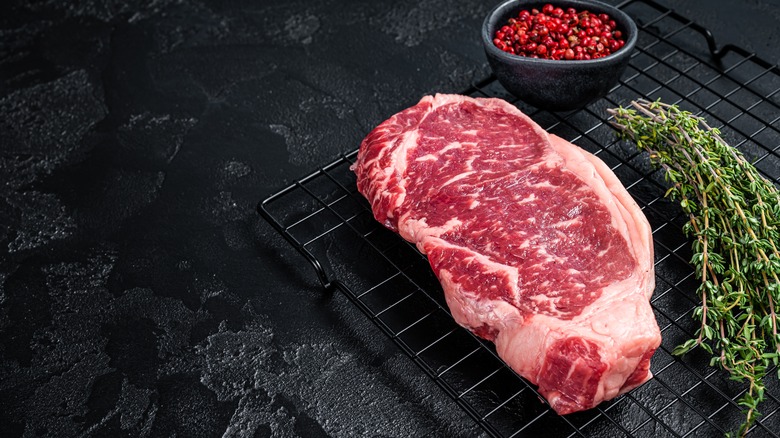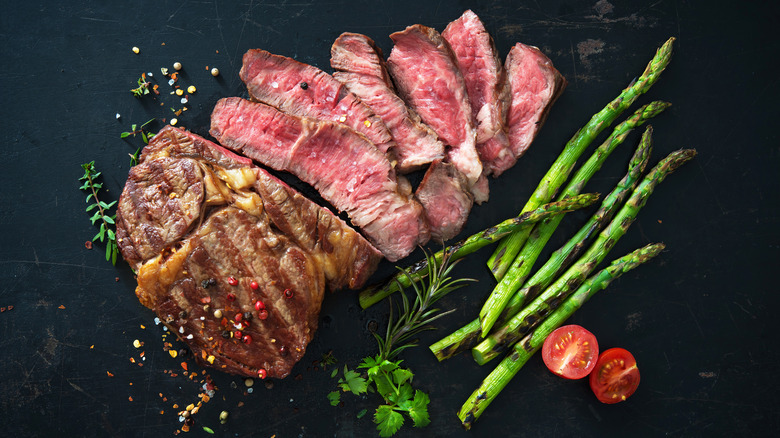The Tender Difference Between New York Strip And Ribeye Steak
Two beloved cuts of beef you'll see on many steakhouse menus are New York strip and ribeye, and although they both have their delicious perks and a lot of similarities, they're not identical. New York strip and ribeye come from similar areas of the cow's back; the ribeye, unsurprisingly, is from the ribs, while the New York strip is from the next section back, called the short loin.
Both are also considered pretty high-grade, tender cuts, but perhaps the biggest difference between the two comes down to fat. Ribeye has more marbling (the strips of fat that you can see in a steak) running between the red meat that makes up the bulk of the meat cut. This higher proportion of fat makes the ribeye a little more tender than the New York strip, though the latter is certainly not tough. Although the New York strip has less marbling than a ribeye in general, it sometimes has a large strip of fat along the side of the steak, but that generally isn't eaten. Of course, this also means that the ribeye is fattier in general, and while steak probably isn't the number one food for those looking to cut back their fat intake, those who are conscious of it may want to opt for the leaner New York strip, between these two.
Cooking with ribeye and New York strip
This fat content makes an impact on how the steaks are cooked. If you're nervous about cooking steak, ribeye may be a wise choice, since the higher fat content means it'll stay juicier even if it's overcooked a little. The lower fat content means that while it's still tender, the New York strip has a slightly chewier texture, and it's a little more likely to dry out when you're cooking with it, although a 1-inch thick steak should work nicely. Naturally, this shouldn't be an issue if you're dining at a steakhouse where professionals are handling the steak.
Whether grilling or pan-frying, you'll generally want to cook a New York strip steak on higher heat, so it has less chance to dry out. A ribeye can also benefit from high heat (particularly to sear it at the start) but can be finished off at a medium temperature. Be warned, though: The fattier rib-eye may cause your grill to flare up, so cook with caution. As for the end product, while both have a deep, meaty flavor, the ribeye will tend to be a bit richer, thanks to its fatty marbling.
Other differences to know
If you're watching your wallet, it's worth knowing that New York strip steaks are usually a bit cheaper than ribeye. The difference isn't huge (probably a couple of dollars per pound), with New York strip costing around $10 to $15 per pound and ribeye sitting at $12 to $16 in a grocery store or butcher shop. In a steakhouse, expect much higher prices, but following the same pattern of ribeye being a fraction more expensive.
There's one exception, though; bone-in ribeye may be similar in price or even cheaper than a New York strip steak. Of course, that's because you're paying for the inedible bone, but some steak lovers go for bone-in options as the fat and muscle around it may impart extra flavor. While bone-in ribeye is somewhat common, bone-in strip steak isn't something you'll see quite as often. If a New York strip steak has a bone, it's usually sold as a T-bone or porterhouse steak, which includes another cut of beef (the tenderloin) on the other side of the bone.
Ultimately, the New York strip steak and the ribeye steak are pretty similar cuts of meat, but if you are conscious of your fat intake or looking to save a few bucks, you might find that those subtle differences matter.


